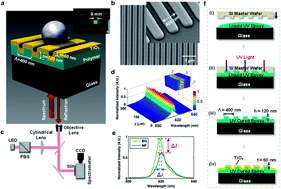Photonic crystal enhanced microscopy (PCEM) is a relatively new technique that utilizes a grating like substrate composed of a high refractive index material coating a low refractive index one. When irradiated with light at a resonant wavelength, this photonic crystal reflects all of the light, and is very sensitive to any changes on the surface.

Photonic Crystal Enhanced Microscopy of a nanoparticle on a photonic crystal
Researchers at the University of Illinois in the United States studied the effects of gold nanoparticles binding to photonic crystals composed of a liquid epoxy polymer and TiO2. Although PCEM has been used to detect biological analytes without labels, they observed how a nanoparticle tag can reduce the signal of a photonic crystal. Furthermore, they determined the distance required between the nanoparticles for detection, and this could be used in future amplification schemes such as in single molecule sensing.
To read more about this topic, click the link below. It will be free to read until February 28.
Single nanoparticle detection using photonic crystal enhanced microscopy
Yue Zhuo, Huan Hu, Weili Chen, Meng Lu, Limei Tian, Hojeong Yu, Kenneth D. Long, Edmond Chow, William P. King, Srikanth Singamaneni and Brian T. Cunningham
Analyst, 2014, Advance Article
DOI: 10.1039/C3AN02295A










